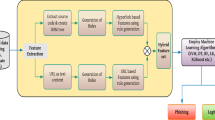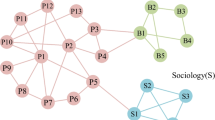Abstract
The heterogeneity of a network causes major challenges for link prediction in heterogeneous complex networks. To deal with this problem, supervised link prediction could be applied to integrate heterogeneous features extracted from different nodes/relations. However, supervised link prediction might be faced with highly imbalanced data issues which results in undesirable false prediction rate. In this paper, we propose a new kernel-based one-class link predictor in heterogeneous complex networks. Assuming a set of available meta-paths, a graph kernel is extracted based on each meta-path. Then, they are combined to form a single kernel function. Afterwards, one class support vector machine (OC-SVM) would be applied on the positive node pairs to train the link predictor. The proposed method has been compared with popular link predictors using DBLP network. The results show that the method outperforms other conventional link predictors in terms of prediction performances.






Similar content being viewed by others
References
Loudcher S, Jakawat W, Morales EP, Favre C (2015) Combining OLAP and information networks for bibliographic data analysis: a survey. Scientometrics 103(2):471–87
Agreste S, De Meo P, Ferrara E, Piccolo S, Provetti A (2015) Analysis of a heterogeneous social network of humans and cultural objects. IEEE Trans Syst Man Cybern Syst 45(4):559–570
Gao H, Liu H (2015) Mining human mobility in Location-Based social networks. Synthesis Lectures on Data Mining and Knowledge Discovery 7(2):1–115
Himmelstein DS, Baranzini SE (2015) Heterogeneous network edge prediction: a data integration approach to prioritize disease-associated genes. PLoS Comput Biol 11(7):e1004259
Lü L, Jin C-H, Zhou T (2009) Similarity index based on local paths for link prediction of complex networks. Phys Rev E 80(4):046122
Sun Y, Barber R, Gupta M, Aggarwal CC, Han J (2011) Co-author relationship prediction in heterogeneous bibliographic networks. In: International conference on advances in social networks analysis and mining (ASONAM). IEEE, pp 121–128
Lao N, Cohen WW (2010) Relational retrieval using a combination of path-constrained random walks. Mach Learn 81(1):53–67
Sun Y, Han J, Yan X, Yu PS, Wu T (2011) Pathsim: meta path-based top-k similarity search in heterogeneous information networks. In: PVLDB, vol 4(11)
Sun Y, Han J (2013) Mining heterogeneous information networks: a structural analysis approach. ACM SIGKDD Explorations Newsletter 14(2):20–28
Liang W et al (2017) Supervised ranking framework for relationship prediction in heterogeneous information networks. Appl Intell 1–17. https://link.springer.com/article/10.1007/s10489-017-1044-7
Gupta M, Kumar P, Bhasker B (2017) Heteclass: a meta-path based framework for transductive classification of objects in heterogeneous information networks. Expert Syst Appl 68:106–122
Shakibian H, Charkari NM, Jalili S (2016) A multilayered approach for link prediction in heterogeneous complex networks. Journal of Computational Science 17:73–82
Lü L, Zhou T (2011) Link prediction in complex networks: a survey. Physica A: Statistical Mechanics and its Applications 390(6):1150–1170
Shi C et al (2017) A survey of heterogeneous information network analysis. IEEE Trans Knowl Data Eng 29(1):17–37
Fire M et al (2013) Computationally efficient link prediction in a variety of social networks. ACM Trans Intell Syst Technol (TIST) 5(1):10
Bao Z, Zeng Y, Tay YC (2013) SonLP: social network link prediction by principal component regression. In: IEEE/ACM international conference on advances in social networks analysis and mining (ASONAM), 2013. IEEE
Kuo T-T et al (2013) Unsupervised link prediction using aggregative statistics on heterogeneous social networks. In: Proceedings of the 19th ACM SIGKDD international conference on knowledge discovery and data mining. ACM
Al Hasan M et al (2006) Link prediction using supervised learning. In: SDM06: workshop on link analysis, counter-terrorism and security
Tylenda T, Angelova R, Bedathur S (2009) Towards time-aware link prediction in evolving social networks. In: Proceedings of the 3rd workshop on social network mining and analysis. ACM
Zhang Q, Yu H (2014) Computational approaches for predicting biomedical research collaborations. PloS One 9(11):e111795
Yang Y et al (2012) Predicting links in multi-relational and heterogeneous networks. In: 2012 IEEE 12th international conference on data mining, IEEE
Kong X, Zhang J, Yu PS (2013) Inferring anchor links across multiple heterogeneous social networks. In: Proceedings of the 22nd ACM international conference on information & knowledge management. ACM
Davis D, Lichtenwalter R, Chawla NV (2011) Multi-relational link prediction in heterogeneous information networks. In: International conference on advances in social networks analysis and mining (ASONAM), 2011. IEEE
Meng C, Cheng R, Maniu S, Senellart P, Zhang W (2015) Discovering meta-paths in large heterogeneous information networks. In: Proceedings of the 24th international conference on world wide web. International world wide web conferences steering committee, pp 754–764
Shi B, Weninger T (2014) Mining interesting meta-paths from complex heterogeneous information networks. In: IEEE international conference on data mining workshop (ICDMW), 2014. IEEE, pp 488–495
Xiong Y, Zhu Y, Yu PS (2015) Top-k similarity join in heterogeneous information networks. IEEE Trans Knowl Data Eng 27(6):1710–1723
Shi C et al (2014) Hetesim: a general framework for relevance measure in heterogeneous networks. IEEE Trans Knowl Data Eng 26(10):2479–2492
Meng X et al (2014) Relevance measure in large-scale heterogeneous networks. In: Asia-Pacific web conference. Springer, Cham
Jeh G, Widom J (2002) Simrank: a measure of structural-context similarity. In: Proceedings of the eighth ACM SIGKDD international conference on knowledge discovery and data mining. ACM
Shakibian H, Charkari NM (2017) Mutual information model for link prediction in heterogeneous complex networks. Sci Rep 7:1–16
Zhu B, Xia Y (2015) An information-theoretic model for link prediction in complex networks. Sci Rep 5:13707
Lichtenwalter RN, Lussier JT, Chawla NV (2010) New perspectives and methods in link prediction. In: Proceedings of the 16th ACM SIGKDD international conference on knowledge discovery and data mining. ACM
Kong X, Yu PS, Ding Y, Wild DJ (2012) Meta path-based collective classification in heterogeneous information networks. In: Proceedings of the 21st ACM international conference on information and knowledge management. ACM, pp 1567–1571
Li J et al (2017) Meta-path based heterogeneous combat network link prediction. Physica A: Statistical Mechanics and its Applications 482:507–523
Cao X et al (2017) Meta-path-based link prediction in schema-rich heterogeneous information network. International Journal of Data Science and Analytics 3(4):285–296
Zhang J, Yu PS, Zhou Z -H (2014) Meta-path based multi-network collective link prediction. In: Proceedings of the 20th ACM SIGKDD international conference on knowledge discovery and data mining. ACM, pp 1286–1295
Hao T et al (2016) Reconstruction and application of protein–protein interaction network. Int J Mol Sci 17(6):907
Zhuang L, Dai H (2006) Parameter optimization of kernel-based one-class classifier on imbalance learning. Journal of Computers 1(7):32–40
Ley M (2009) DBLP: Some lessons learned. In: PVLDB, vol 2(2)
Li X, Chen H (2013) Recommendation as link prediction in bipartite graphs: a graph kernel-based machine learning approach. Decis Support Syst 54(2):880–890
Vishwanathan SVN, Schraudolph NN, Kondor R, Borgwardt KM (2010) Graph kernels. J Mach Learn Res 11:1201–1242
Bai L, Hancock ER (2013) Graph kernels from the jensen-shannon divergence. J Math Imaging Vision 47(1-2):60–69
Li X, Wang M, Liang T -P (2014) A multi-theoretical kernel-based approach to social network-based recommendation. Decis Support Syst 65:95–104
Wu B, Yuan C, Hu W (2014) Human action recognition based on context-dependent graph kernels. In: Proceedings of the IEEE conference on computer vision and pattern recognition, pp 2609–2616
Li X, Chen H, Li J, Zhang Z (2010) Gene function prediction with gene interaction networks: a context graph kernel approach. IEEE Trans Inf Technol Biomed 14(1):119–128
Tan F, Xia Y, Zhu B (2014) Link prediction in complex networks: a mutual information perspective. PloS One 9(9):e107056
Gönen M, Alpaydın E (2011) Multiple kernel learning algorithms. J Mach Learn Res 12:2211–2268
Li X, Wang M, Liang T -P (2014) A multi-theoretical kernel-based approach to social network-based recommendation. Decis Support Syst 65:95–104
Schölkopf B, Platt JC, Shawe-Taylor J, Smola AJ, Williamson RC (2001) Estimating the support of a high-dimensional distribution. Neural Comput 13(7):1443–1471
Huang J, Sun H, Song Q, Deng H, Han J (2013) Revealing density-based clustering structure from the core-connected tree of a network. IEEE Trans Knowl Data Eng 25(8):1876–1889
Sun Y, Norick B, Han J, Yan X, Yu PS, Yu X (2013) Pathselclus: integrating meta-path selection with user-guided object clustering in heterogeneous information networks. ACM Trans Knowl Discov Data (TKDD) 7(3):11
Tang J et al (2008) Arnetminer: extraction and mining of academic social networks. In: Proceedings of the 14th ACM SIGKDD international conference on knowledge discovery and data mining. ACM
Chang C-C, Lin C-J (2001) LIBSVM: A library for support vector machines (http://www.scie.ntu.edu.tw/cjlin/libsvm)
Liu J et al (2016) A link prediction algorithm based on label propagation. Journal of Computational Science 16:43–50
Fawcett T (2004) ROC Graphs: notes and practical considerations for researchers. Mach Learn 31(1):1–38
Yu X, Gu Q, Zhou M, Han J (2012) Citation prediction in heterogeneous bibliographic networks. In: SDM, vol 12, pp 1119–1130
Srinivas V, Mitra P (2016) Link prediction in social networks: role of power law distribution. Springer International Publishing
Do H et al (2009) Margin and radius based multiple kernel learning. In: Machine learning and knowledge discovery in databases, pp 330–343
Yang H et al (2011) Efficient sparse generalized multiple kernel learning. IEEE Trans Neural Netw 22 (3):433–446
Author information
Authors and Affiliations
Corresponding author
Rights and permissions
About this article
Cite this article
Shakibian, H., Charkari, N.M. & Jalili, S. Multi-kernel one class link prediction in heterogeneous complex networks. Appl Intell 48, 3411–3428 (2018). https://doi.org/10.1007/s10489-018-1157-7
Published:
Issue Date:
DOI: https://doi.org/10.1007/s10489-018-1157-7




